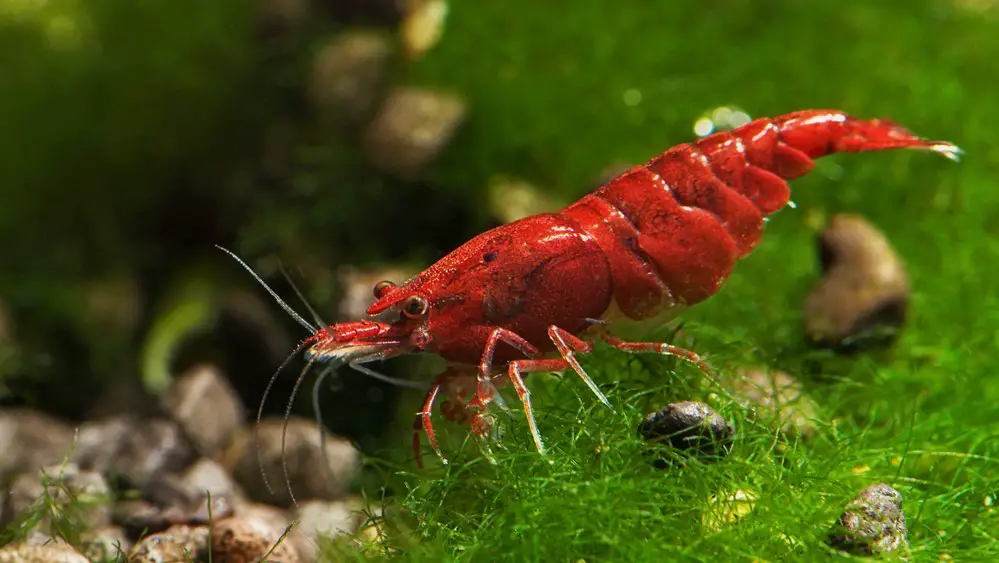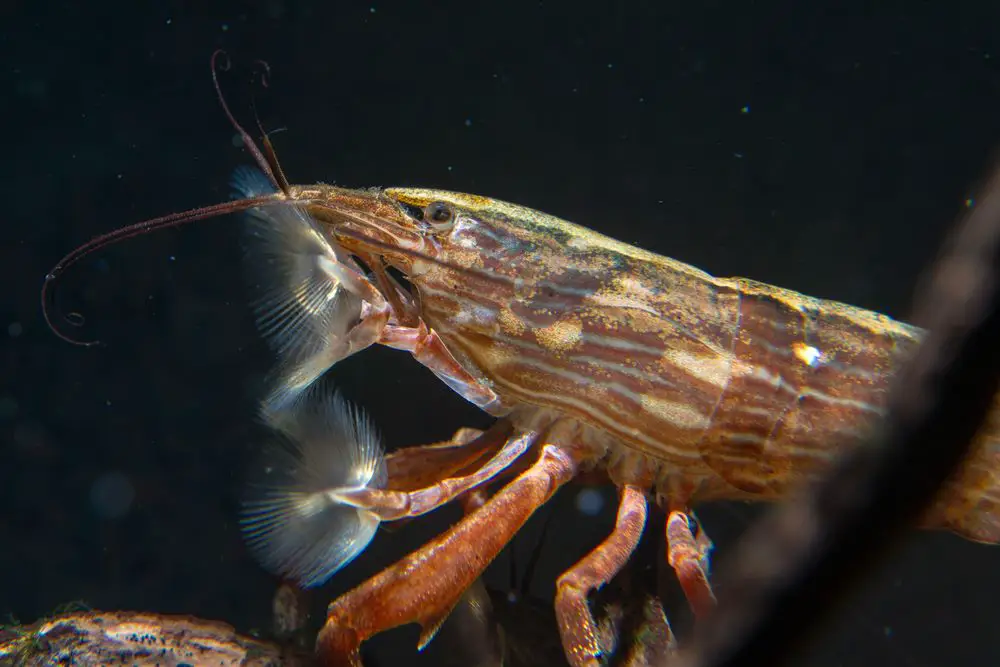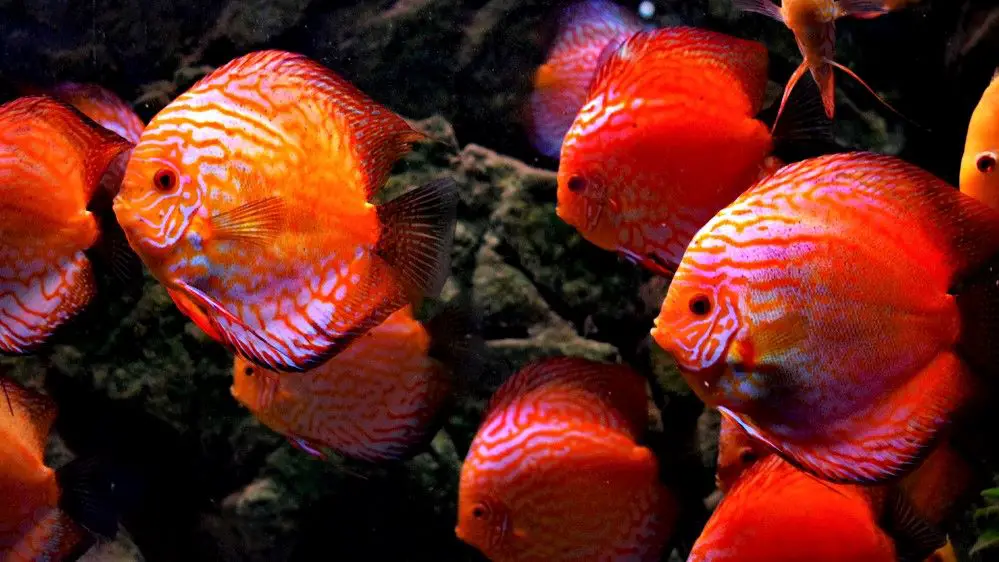So you have a discus tank, and you are wondering if you could add a pop of color with some cherry shrimp? Or perhaps you’ve been captivated by the lively antics of these tiny crustaceans and thought they’d make a great addition to your aquarium. Well, you’re not alone. Many shrimp keepers have pondered this question, and today, we will delve into it.
Unfortunately, the answer is no. Discus are likely to hunt down cherry shrimp and snack on them. However, larger shrimp species such as Amano and Bamboo could potentially coexist with Discus.
As a seasoned shrimp keeper, I’ve had my fair share of trials and tribulations. One of the biggest challenges I’ve faced over the years is finding the right tank mates for my shrimp. I remember the time I thought about introducing cherry shrimp into my discus tank. I was drawn to their vibrant color and thought they would add a nice contrast to my discus.
However, after extensive research and consultation with fellow shrimp keepers, I learned that this was not a good idea. Discus, as it turns out, have a penchant for snacking on cherry shrimp. This was a tough pill to swallow, especially after imagining the beautiful, diverse ecosystem I could have created.
Over time, I discovered that larger shrimp species like Amano and Bamboo shrimp could potentially share a tank with discus. This discovery was a game-changer and opened up new possibilities for my aquarium.
In this article, we’ll explore why cherry shrimp and discus don’t mix, and what alternatives you can consider. So, if you’re a shrimp keeper contemplating a similar move, stick around. There’s a lot to learn from my journey.

Why Can’t Cherry Shrimp Live with Discus?
When it comes to keeping shrimp and discus together, the primary issue lies in discus fish’s natural behaviors and dietary preferences. Discus are a type of cichlid, a family of fish known for their predatory instincts.
They are opportunistic feeders, meaning they will eat whatever is available in their environment that fits into their mouths. Unfortunately, cherry shrimp fit the bill perfectly with their small size and slow movement.
Cherry shrimp are vibrant, active, and incredibly interesting to watch, but their small size makes them an easy target for larger, predatory fish like discus. In the wild, discus are used to hunting for their food, and the movement of cherry shrimp can trigger their hunting instincts.
This means that instead of cohabitating peacefully, discus are likely to see cherry shrimp as a tasty snack.
The combination of predatory behavior and size difference make it challenging for cherry shrimp and discus to share a tank peacefully.

What Makes Amano and Bamboo Shrimp Suitable Tank Mates for Discus?
When it comes to finding suitable tank mates for discus, Amano and Bamboo shrimp often come up as viable options. But what makes these shrimp species more suitable than others, such as the cherry shrimp?
Firstly, Amano and Bamboo shrimp are significantly larger than cherry shrimp. Amano shrimp can grow up to 2 inches, and Bamboo shrimp can reach an impressive size of up to 5 inches.
This size difference is crucial as it makes them less likely to be seen as prey by the discus. Their larger size doesn’t trigger the discus’ predatory instincts like smaller shrimp do, allowing them to coexist more peacefully.
Secondly, both Amano and Bamboo shrimp are less brightly colored than cherry shrimp. Their more subdued coloration helps them blend into the tank environment, making them less noticeable to the discus.
This camouflage can be a lifesaver in a tank with potential predators.
Lastly, Amano and Bamboo shrimp are more adaptable to the warmer water temperatures preferred by discus.
This compatibility in temperature preferences reduces stress and promotes healthier living conditions for both the shrimp and the discus.
The larger size, less vibrant coloration, and adaptability to warmer water temperatures of Amano and Bamboo shrimp make them more suitable tank mates for discus compared to cherry shrimp.

How Can I Introduce Amano or Bamboo Shrimp to a Discus Tank?
Introducing Amano or Bamboo shrimp to a discus tank requires careful planning and execution to ensure a smooth transition and minimize stress for all inhabitants. Here’s a step-by-step guide on how to do it.
Before introducing the shrimp, it’s crucial to ensure your tank is well-established and stable. Amano and Bamboo shrimp are sensitive to changes in water parameters, so your tank should have consistent pH, temperature, and nitrate levels.
It’s also beneficial to have plenty of hiding spots in the tank, such as plants, rocks, or driftwood. These provide the shrimp with a sense of security and places to retreat if they feel threatened.
When you bring your new shrimp home, please don’t add them to the tank immediately. Instead, use the drip acclimation method to introduce them to the tank’s water gradually.
This slow process helps the shrimp adjust to the new water parameters and reduces the risk of shock.
Once the acclimation process is complete, gently net the shrimp and add them to the tank. Avoid adding water from the bag or container into the tank to prevent potential contaminants from entering your established ecosystem.
the shrimp and add them to the tank. Avoid adding water from the bag or container into the tank to prevent potential contaminants from entering your established ecosystem.
After introducing the shrimp, monitor their behavior and the behavior of the discus closely for the next few days. Look for signs of aggression from the discus and ensure the shrimp eat and behave normally.
Every tank and its inhabitants are unique. What works for one may not work for another. Always be prepared to make adjustments or even remove the shrimp if necessary to ensure the health and safety of all your tank’s inhabitants.

What are the Signs of a Successful Discus and Shrimp Cohabitation?
Recognizing the signs of a successful cohabitation between discus and shrimp can help ensure the health and happiness of your aquarium’s inhabitants. Here’s what to look for.
One of the most apparent signs of successful cohabitation is the absence of aggression. Discus should not be actively chasing or showing signs of aggression towards the shrimp. Similarly, the shrimp should not constantly hide or show signs of stress, such as erratic swimming or loss of color.
Another positive sign is that both the discus and shrimp are eating well. Shrimp should be seen grazing on algae and biofilm in the tank, and discus should be eating their regular diet without showing an excessive interest in the shrimp.
If the discus are ignoring their usual food in favor of trying to eat the shrimp, this could be a sign of unsuccessful cohabitation.
Healthy behavior is another indicator of success. Discus should be displaying their usual behavior, such as swimming freely and interacting with each other. Shrimp should also behave normally, which includes exploring the tank, grazing, and molting regularly.
Lastly, overall health is a key indicator. Both discus and shrimp should appear healthy, with vibrant colors, clear eyes, and no signs of disease or injury. If either species starts showing signs of illness, it could be a sign that the cohabitation is not working and adjustments need to be made.
Successful cohabitation between discus and shrimp is characterized by peaceful interactions, healthy eating and behavior, and overall good health. Regular observation and understanding of your tank inhabitants’ normal behavior are crucial in assessing the success of cohabitation.
In Closing
Ultimately, successfully keeping discus and shrimp together in the same tank requires careful planning, a good understanding of each species’ needs, and constant observation.
While cherry shrimp may not be the best choice due to their small size and the discus’ predatory instincts, larger shrimp like Amano and Bamboo shrimp can potentially share a tank with discus.
Remember, the key to a thriving aquarium is maintaining stable water parameters, providing plenty of hiding spots, and ensuring a peaceful coexistence between all inhabitants.
On a final note, don’t be disheartened if things don’t work out perfectly the first time. Aquarium keeping is a journey filled with learning and adjustments.
If you need any help or have questions, don’t hesitate to reach out. If you can’t reach me here, check out the aquarium shrimp keeping group on Facebook. A whole community of fellow shrimp keepers is ready to help and share their experiences.
Happy Shrimp and Discus Keeping!
FAQ on Discus and Shrimp Cohabitation
Q. Can cherry shrimp live with discus?
A. No, cherry shrimp are not ideal tank mates for discus. Their small size and vibrant color make them an easy target for the discus, which are predatory by nature. Additionally, the preferred water temperatures for discus and cherry shrimp differ significantly, which can lead to stress and health problems for the shrimp.
Q. Can shrimp be kept with discus?
A. Yes, but the choice of shrimp species is crucial. Larger shrimp like Amano and Bamboo shrimp are more suitable tank mates for discus due to their size, less vibrant coloration, and adaptability to warmer water temperatures.
Q. What fish not to keep with cherry shrimp?
A. Any large, predatory fish, including discus, are not suitable tank mates for cherry shrimp. These fish may see the small, slow-moving shrimp as an easy meal.
Q. What can I keep with discus fish?
A. Discus can be kept with a variety of tank mates, including certain species of shrimp (like Amano and Bamboo shrimp), smaller non-aggressive fish, and snails. It’s important to consider the size, temperament, and environmental needs of any potential tank mates.
Q. Will discus eat my shrimps?
A. Discus may eat smaller shrimp like cherry shrimp due to their predatory nature. However, larger shrimp such as Amano and Bamboo shrimp are less likely to be eaten due to their size.
